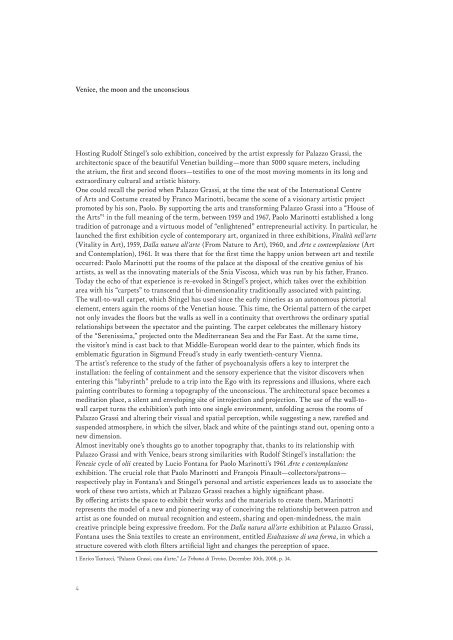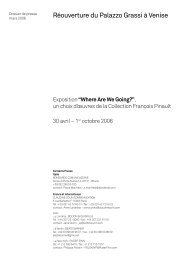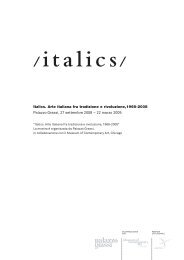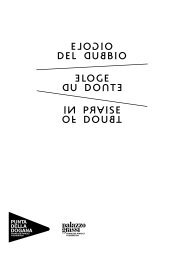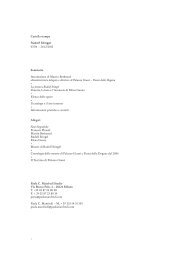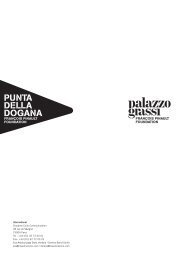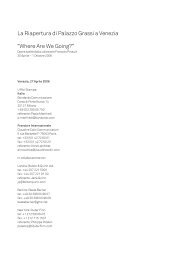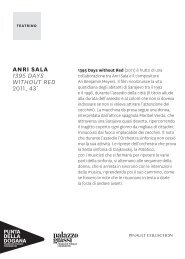Press kit Rudolf Stingel 07/04 â 31/12/2013 ... - Palazzo Grassi
Press kit Rudolf Stingel 07/04 â 31/12/2013 ... - Palazzo Grassi
Press kit Rudolf Stingel 07/04 â 31/12/2013 ... - Palazzo Grassi
Create successful ePaper yourself
Turn your PDF publications into a flip-book with our unique Google optimized e-Paper software.
Venice, the moon and the unconscious<br />
Hosting <strong>Rudolf</strong> <strong>Stingel</strong>’s solo exhibition, conceived by the artist expressly for <strong>Palazzo</strong> <strong>Grassi</strong>, the<br />
architectonic space of the beautiful Venetian building—more than 5000 square meters, including<br />
the atrium, the first and second floors—testifies to one of the most moving moments in its long and<br />
extraordinary cultural and artistic history.<br />
One could recall the period when <strong>Palazzo</strong> <strong>Grassi</strong>, at the time the seat of the International Centre<br />
of Arts and Costume created by Franco Marinotti, became the scene of a visionary artistic project<br />
promoted by his son, Paolo. By supporting the arts and transforming <strong>Palazzo</strong> <strong>Grassi</strong> into a “House of<br />
the Arts” 1 in the full meaning of the term, between 1959 and 1967, Paolo Marinotti established a long<br />
tradition of patronage and a virtuous model of “enlightened” entrepreneurial activity. In particular, he<br />
launched the first exhibition cycle of contemporary art, organized in three exhibitions, Vitalità nell’arte<br />
(Vitality in Art), 1959, Dalla natura all’arte (From Nature to Art), 1960, and Arte e contemplazione (Art<br />
and Contemplation), 1961. It was there that for the first time the happy union between art and textile<br />
occurred: Paolo Marinotti put the rooms of the palace at the disposal of the creative genius of his<br />
artists, as well as the innovating materials of the Snia Viscosa, which was run by his father, Franco.<br />
Today the echo of that experience is re-evoked in <strong>Stingel</strong>’s project, which takes over the exhibition<br />
area with his “carpets” to transcend that bi-dimensionality traditionally associated with painting.<br />
The wall-to-wall carpet, which <strong>Stingel</strong> has used since the early nineties as an autonomous pictorial<br />
element, enters again the rooms of the Venetian house. This time, the Oriental pattern of the carpet<br />
not only invades the floors but the walls as well in a continuity that overthrows the ordinary spatial<br />
relationships between the spectator and the painting. The carpet celebrates the millenary history<br />
of the “Serenissima,” projected onto the Mediterranean Sea and the Far East. At the same time,<br />
the visitor’s mind is cast back to that Middle-European world dear to the painter, which finds its<br />
emblematic figuration in Sigmund Freud’s study in early twentieth-century Vienna.<br />
The artist’s reference to the study of the father of psychoanalysis offers a key to interpret the<br />
installation: the feeling of containment and the sensory experience that the visitor discovers when<br />
entering this “labyrinth” prelude to a trip into the Ego with its repressions and illusions, where each<br />
painting contributes to forming a topography of the unconscious. The architectural space becomes a<br />
meditation place, a silent and enveloping site of introjection and projection. The use of the wall-towall<br />
carpet turns the exhibition’s path into one single environment, unfolding across the rooms of<br />
<strong>Palazzo</strong> <strong>Grassi</strong> and altering their visual and spatial perception, while suggesting a new, rarefied and<br />
suspended atmosphere, in which the silver, black and white of the paintings stand out, opening onto a<br />
new dimension.<br />
Almost inevitably one’s thoughts go to another topography that, thanks to its relationship with<br />
<strong>Palazzo</strong> <strong>Grassi</strong> and with Venice, bears strong similarities with <strong>Rudolf</strong> <strong>Stingel</strong>’s installation: the<br />
Venezie cycle of olii created by Lucio Fontana for Paolo Marinotti’s 1961 Arte e contemplazione<br />
exhibition. The crucial role that Paolo Marinotti and François Pinault—collectors/patrons—<br />
respectively play in Fontana’s and <strong>Stingel</strong>’s personal and artistic experiences leads us to associate the<br />
work of these two artists, which at <strong>Palazzo</strong> <strong>Grassi</strong> reaches a highly significant phase.<br />
By offering artists the space to exhibit their works and the materials to create them, Marinotti<br />
represents the model of a new and pioneering way of conceiving the relationship between patron and<br />
artist as one founded on mutual recognition and esteem, sharing and open-mindedness, the main<br />
creative principle being expressive freedom. For the Dalla natura all’arte exhibition at <strong>Palazzo</strong> <strong>Grassi</strong>,<br />
Fontana uses the Snia textiles to create an environment, entitled Esaltazione di una forma, in which a<br />
structure covered with cloth filters artificial light and changes the perception of space.<br />
1 Enrico Tantucci, “<strong>Palazzo</strong> <strong>Grassi</strong>, casa d’arte,” La Tribuna di Treviso, December 30th, 2008, p. 34.<br />
4


